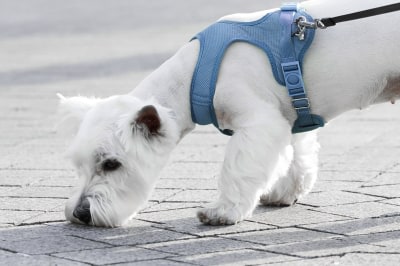A urinalysis test can help detect several conditions and diseases that your cat or dog may have. Today, our Oklahoma City vets discuss the importance of regular urinalysis testing for pets.
Urinalysis for Dogs & Cats
A urinalysis is a simple diagnostic test that determines the physical and chemical properties of urine. It is primarily used to evaluate the health of the kidneys and urinary system, but it can also reveal issues with other organ systems. All senior pets eight years of age and older should have a yearly urinalysis. A urinalysis may also be recommended if your pet has increased water intake, increased frequency of urination, or visible blood in the urine.
Collecting a Urine Sample
There are three main ways to collect urine from cats and dogs:
Cystocentesis: A sterile needle and syringe are used to collect urine from the bladder. The advantage of cystocentesis is that lower urinary tract debris does not contaminate the urine. This sample is ideal for assessing the bladder and kidneys and detecting bacterial infection. The procedure is slightly more invasive than others and is only useful when the pet's bladder is full.
Catheterization: Catheterization is a less invasive method of extracting urine from the bladder in dogs and is an excellent choice when a voluntary sample is unavailable, particularly in male dogs. A very narrow sterile catheter is inserted into the bladder through the lower urinary passage (called the urethra).
Mid-stream Free Flow: The pet urinates voluntarily, and a sample is collected into a sterile container as the pet urinates. This type of sample is frequently referred to as a "free flow" or "free catch" sample. The benefits of this method include the fact that it is completely non-invasive and that the pet owner can collect a urine sample at home.
Understanding the Results of a Urinalysis
There are four main parts to a urinalysis:
- Assess appearance: color and turbidity (cloudiness).
- Measure the concentration (also known as the density) of the urine.
- Measure pH (acidity) and analyze the chemical composition of the urine.
- Examine the cells and solid material (urine sediment) present in the urine using a microscope.
Other factors (such as crystals, bacteria, and cells) can alter the composition of urine samples (dissolve or multiply) within thirty minutes of collection. Please return any urine samples collected at home as soon as possible to your veterinarian's office. Unless we are assessing your pet's ability to concentrate urine or screening for Cushing's disease, the timing of urine collection is typically irrelevant. In contrast, if we are screening for Cushing's disease or assessing your pet's ability to concentrate urine, we require a morning urine sample.
Color & Turbidity
Urine ranging in hue from pale yellow to light amber and in clarity from transparent to slightly cloudy. Urine that is dark yellow in color usually indicates that the animal needs to consume more water or is dehydrated. Urine of a color other than yellow (such as orange, red, brown, or black) may contain substances not normally found in healthy urine and may indicate an underlying health problem.
Increased turbidity or cloudiness in the urine indicates the presence of cells or other solid materials. Turbidity increases when there is blood, inflammatory cells, crystals, mucus, or debris present. The sediment will be examined to determine what is present and whether it is significant.
Concentration
Consider concentration to be the density of the urine. A healthy kidney produces dense (concentrated) urine, whereas watery (dilute) urine in dogs and cats may indicate underlying disease.
If there is an excess of water in the body, the kidneys allow it to exit through the urine, making it more watery or dilute. If there is a water deficiency, the kidneys reduce the amount of water lost in the urine, thereby increasing its concentration.
If a dog or cat passes dilute urine from time to time, it is not necessarily a cause for concern. If a pet continuously passes dilute urine, there may be an underlying kidney or metabolic disease that requires further investigation.
pH & Chemical Composition
The pH level of the urine indicates its acidity. The pH of urine in healthy pets is usually between 6.5 and 7.0. If the pH is acidic (pH less than 6) or alkaline (pH greater than 7), bacteria can thrive and crystals or stones can form.
Normal variations in urine occur throughout the day, particularly after consuming certain foods and medications. If the remainder of the urinalysis is normal, a single pH reading of urine is not cause for concern. Your veterinarian may wish to investigate further if the condition persists.
Cells & Solid Material (Urine Sediment)
Some of the cells present in your pet's urine can include:
Red Blood Cells: Red blood cells may indicate bladder wall or kidney trauma or irritation. In pets with bladder or kidney infections, bladder stones, or interstitial cystitis, the technician will find red blood cells in the urine. It may also be an early sign of cancer of the urinary tract.
White Blood Cells: White blood cells could indicate an infection or an inflammatory process in the bladder or kidney.
Protein: Protein should not be found in urine on a dipstick test. A positive protein in urine test may indicate a bacterial infection, kidney disease, or blood in the urine.
Sugar: Urine should not contain any sugar. The presence of sugar in the urine may signal the presence of Diabetes mellitus.
Ketones: If your pet tests positive for ketones in its urine, a Diabetes Mellitus workup will be performed. Ketones are abnormal byproducts that your pet's cells produce when they lack an adequate energy source.
Bilirubin: Bilirubinuria is an abnormal finding indicating that the red blood cells in your pet's bloodstream are dividing at a faster rate than is typical. It has been discovered in animals with liver disease and autoimmune diseases. Remember that pets with blood in their urine due to a bladder infection can erroneously stain the bilirubin pad on the dipstick, raising the possibility of a more serious liver condition.
Urobilinogen: Urobilinogen in urine indicates that the bile duct is open and bile can flow from the gallbladder into the intestine.
Blood: Blood in a dog's or cat's urine can indicate an infection, an inflammatory problem, or stones in the bladder or kidney. The dipstick can detect red blood cells or other blood components, such as hemoglobin or myoglobin, in your pet's urine.
Urine Sediment: This should also be examined when conducting a urinalysis. Urine sediment is the material that settles to the bottom of a centrifuge after spinning a urine sample. Red blood cells, white blood cells, and crystals are the most common things found in urine sediment. Small amounts of mucus and other debris are frequently found in free-catch samples.
Crystals: Numerous types of crystals vary in size, shape, and color. Some crystals are one-of-a-kind and can aid in the diagnosis of a specific condition. In more common conditions, such as bladder infections, the crystals provide data that can influence how the disease is treated. Because crystals can form in urine after it has been collected, your veterinarian may want to examine a fresh sample right away.
Bacteria: The presence of bacteria as well as inflammatory cells in the sediment suggests that there is a bacterial infection somewhere in the urinary system. The urine should ideally be sent to a laboratory for culture and sensitivity testing to determine what types of bacteria are present and which antibiotic should be used to treat the infection.
Tissue Cells: While not necessarily a sign of disease, increased cellularity has been linked to several conditions, including urinary tract inflammation, bladder stones, prostate issues, and cancer. Catheterization samples frequently contain an increased number of tissue cells. If the cells appear abnormal, your veterinarian may advise you to have the sediment cytologically prepared. This enables a more in-depth examination of the tissue cells.



